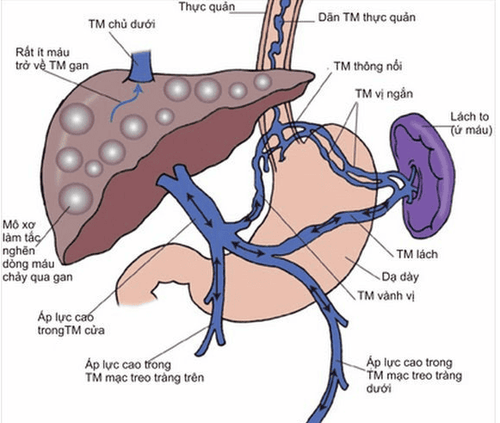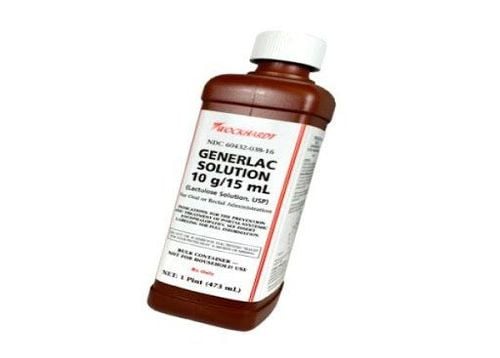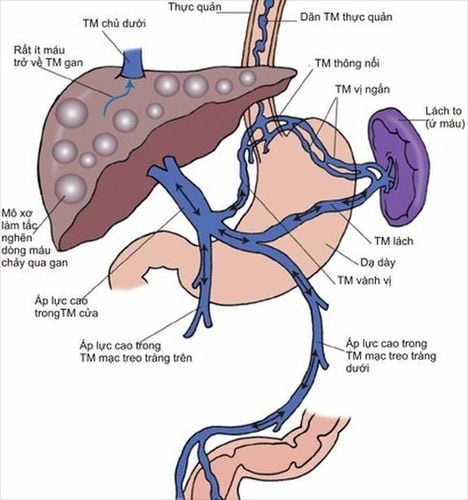This is an automatically translated article.
Cirrhosis is a very dangerous chronic disease with a high mortality rate. A serious complication of cirrhosis is rupture of esophageal varices causing gastrointestinal bleeding, the main cause of increased mortality in patients.
1. Why is cirrhosis of the liver prone to rupture of esophageal veins?
One of the common complications of cirrhosis is bleeding. According to statistics, the rate of rupture of esophageal veins arises in:
People with cirrhosis: more than 30%; 80-90% of bleeding is due to cirrhosis. The cause is the appearance of scar tissue in the liver that obstructs the portal vein flow of red blood cells. Accordingly, the blood pressure here will increase significantly, this condition is called portal hypertension.
A direct consequence of portal hypertension is that red blood cells begin to change their flow to other nearby capillaries, such as the esophageal veins, in order to continue moving. Because of this overload of red blood cells, the capillaries will expand to their fullest extent to accommodate them. However, if they "bulge out" excessively, they can rupture the vein and cause serious bleeding.

Tăng áp lực tĩnh mạch cửa là nguyên nhân dẫn đến vỡ tĩnh mạch thực quản
2. Some statistics on esophageal varices caused by cirrhosis of the liver
According to statistics that researchers have, the rate of people with esophageal varices due to cirrhosis is increasing, leading to an increased risk of bleeding due to esophageal varices. More specifically, the number of people with cirrhosis each year who face problems with esophageal varices will likely increase from 5% to 15%.
Because esophageal varices rupture is the cause of gastrointestinal bleeding, which is life-threatening, so this condition is very dangerous, especially in people with cirrhosis as the underlying disease. According to statistics, the mortality rate in people without cirrhosis will probably be as low as 5% to 10%. In contrast, if you are in the case of esophageal varices due to fibrosis in the liver, the risk of death will increase to 40% - 70%.
On the other hand, in the case of esophageal bleeding due to varicose veins, there is a 40% chance that the body will be able to stop the bleeding on its own. However, the risk of recurrent bleeding is 30% within the next 42 days. Further, within the next 12 months, bleeding will continue to occur at a rate of 70%.
Therefore, if the patient has been diagnosed with cirrhosis, the doctor will recommend some methods to prevent varicose veins and esophageal bleeding.
3. Symptoms of esophageal varices rupture due to cirrhosis of the liver
Patients with ruptured esophageal veins due to cirrhosis often have typical signs as follows:
Patients have vomiting blood (a significant amount of blood); Passing stools that are black; Feeling dizzy; Loss of consciousness (in severe cases); There are manifestations of chronic liver disease such as: yellow skin, yellow eyes, easy bruising and easy bleeding, ...

Vàng da là một biểu hiện rõ rệt của bệnh lý về gan
4. Diagnosis of esophageal varices due to cirrhosis of the liver
When diagnosing liver disease, the doctor will need to combine many different aspects and techniques, including:
Symptoms in the patient; Medical history, conduct clinical examination; Perform blood tests and liver biopsy (if necessary); People with cirrhosis should regularly visit medical facilities to check for esophageal varices through techniques such as endoscopy or computed tomography (CT Scan).
5. Treatment of esophageal varices due to cirrhosis of the liver
Esophageal vein rupture in patients with cirrhosis is the cause of gastrointestinal bleeding. This is a very dangerous, life-threatening complication.
To treat ruptured esophageal varices due to cirrhosis, the patient will first be conducted to stabilize the emergency. After the hemodynamic status is stable, the patient needs early intervention of esophageal varices.
Indications for treatment of esophageal varices when:
The patient has symptoms of vomiting blood and/or passing black stools; Signs of blood loss: Decreased blood pressure, rapid pulse, decreased hemoglobin and red blood cells; Endoscopy: Grade II-III esophageal varices are bleeding.

Bệnh nhân bị vỡ tĩnh mạch thực quản do bệnh xơ gan có triệu chứng nôn ra máu cần được điều trị thắt tĩnh mạch thực quản
6. Prevention of esophageal varices due to cirrhosis of the liver
Currently, there is no method to effectively prevent esophageal varices in cirrhotic patients. Treatment using beta-blockers has been shown to be effective in preventing bleeding, but it cannot prevent varicose veins from forming.
In summary, cirrhosis of the liver can cause esophageal varices to rupture. Early treatment when there is a risk of bleeding is essential, because the risk of death from bleeding is very high and difficult to control. Therefore, if you have been diagnosed with cirrhosis, you should ask your doctor for advice on measures to help prevent possible complications.
With many years of experience in the examination and treatment of digestive diseases, Vinmec International General Hospital has now become one of the major health care centers, capable of examining and screening. and treat many specialized digestive diseases. Therefore, if the patient has a history of cirrhosis or is diagnosed with the disease, they can go to Vinmec International General Hospital to visit and receive support and advice from doctors and experts. to prevent the risk of gastrointestinal bleeding and other dangerous complications of cirrhosis.
Please dial HOTLINE for more information or register for an appointment HERE. Download MyVinmec app to make appointments faster and to manage your bookings easily.













